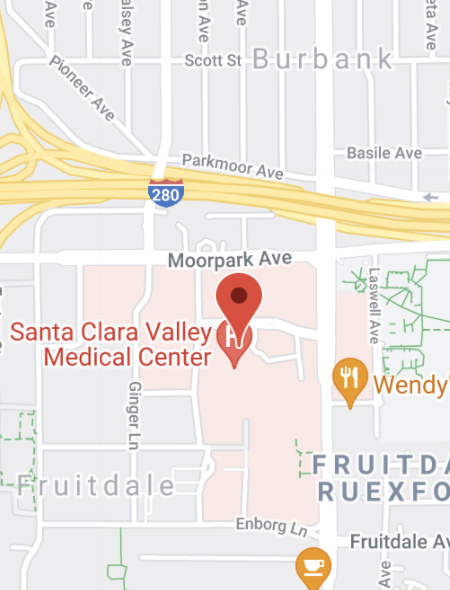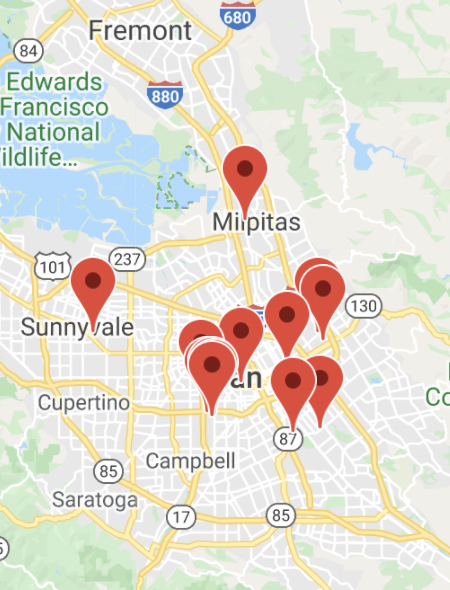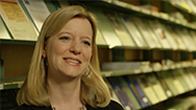INTERNAL MEDICINE RESIDENCY
Overview
Welcome to Santa Clara Valley Medical Center. Our Internal Medicine residency has 18 Categorical and 6 Preliminary PGY1 positions. I would like to share a few of the many things that make me proud of our program.
First, we are a safety-net hospital and our patients define diversity. Over sixty languages are spoken by our patients. After English the most common languages are Spanish, Vietnamese, Mandarin and Farsi, but the entire list runs from Amharic to Visayan. Our patients present with all stages of disease, and you will be the doctor who makes many initial diagnoses. Please click here (2015 Cases, 2018 Cases) to see a list of all the diagnoses my team encountered during my first month on the inpatient wards at Valley in 2015 and during a more recent month in 2018. The diagnoses range from “bread and butter” cases to “zebras” and both are unedited; there is no cherry picking, and no diagnoses were deleted. Another important highlight is how thankful our patients are for the care provided by our residents. Click on the link “From our Residents” to read what our residents value about our program. You make a difference at Valley.
I’m also deeply impressed by our faculty. These are highly-approachable, seasoned clinicians who give you full autonomy while providing direct supervision. Our tight-knit group of core faculty care about your development and provide hands-on mentoring. Residents receive assistance and coaching for a wide range of scholarly activity from preparing grand rounds, to writing clinical vignette abstracts for regional medical conferences, to QI and patient safety projects. Click here to link to residents’ scholarly activity. For residents interested in research there are many mentors here at Valley or at Stanford. When it is time to apply for a fellowship these doctors will guide you through the application process, help you prepare for interviews, and pick up the phone and advocate for you. Also, each resident receives more formal, longitudinal mentorship through regular meetings with an Associate Program Director who will help you develop short and long-term goals.
Our residents are a tight-knit, down-to-earth group of doctors who support and learn from each other. Across the board they are motivated by the desire to be outstanding doctors who provide much needed care to an at-risk patient population. Our residents value hard work, camaraderie, and a spirit of inquiry and want a hands-on program that can help them grow. Our accomplished graduates are highly competitive in getting Hospitalist or Primary Care jobs and in matching into advanced specialties. Click here to see the list of postgraduate careers and follow the links on the left of this page for information specific to your intended career path.
Introduction from
David Jacobson, MD, FACP
Program Director
A Day in the Life

*By clicking on the “Watch External Video” button, you will leave this website, enter a non-County of Santa Clara website, and be subject to the destination website’s privacy policy. Please see our Links Policy for more information.
Other notable features of our program:
4 + 2 block schedule
Categorical interns and residents are on a modified ‘x+y’ block schedule. Most of the time the more “intense” 4-week inpatient blocks (ICU, wards, night float) alternate with less intense 2-week ambulatory or subspecialty inpatient consult blocks. This schedule diminishes the tension between inpatient and outpatient needs and allows for longitudinal QI experience as well as longitudinal subspecialty clinics. Additionally, we work with residents to craft ambulatory rotations targeting their specific individual goals.
Protected time to learn
In September of 2019 we rolled out highly interactive, ‘flipped classroom’ academic afternoons. Interns have protected times on Tuesday afternoons and residents have protected times on Thursday afternoons. These sessions include time to review the previous week’s learning goals, residents teaching residents, and focused, small group case review followed by expert subspecialist debriefing. The sessions are mapped to the ABIM blueprint and are intended to increase medical knowledge and evidence-based decision making.
POCUS CURRICULUM AND SIMULATION SESSIONS
We have a two-tiered POCUS curriculum. All interns are exposed to a longitudinal, hands-on, foundational exposure to the main POCUS skills for Internal Medicine. Our senior residents have the option for a mastery elective during their second or third year that includes self-directed learning and asynchronous feedback on diagnostic studies they have performed.
We also run a ‘code blue 101’ for interns transitioning into their PGY2 year and have noon report sessions dedicated to rapid response and code blue scenarios with a simulation mannequin that occur throughout the academic year.
Individual Learning Pathways
Please see the dedicated page on the ILPs. These pathways are designed to support and strengthen your chosen career arc. They also offer one more level of mentorship: each ILP has dedicated faculty advisors that will help you hone your career goals.
Professor EBM
This curriculum is updated yearly by the Hospitalist group and highlights some of the most important evidence-based literature. Click here to access the both the Learner’s and Teacher’s guides to alcoholic hepatitis. These teaching modules are used on the wards and during weekly EBM noon conferences. Click here to see the full Professor EBM curriculum.
Quality Improvement involvement
All residents are involved in QI/QA beginning with chart audits as interns and continuing with chronic care audits in their 2nd and 3rd years. Some seniors develop more intensive senior QI projects with significant impact. Recent projects include:
- Standardization of note templates to improve documentation
- Reducing unnecessary lab ordering consistent with the Choosing Wisely Campaign
- Improving nursing communication and cutting down on incorrect pages
- Examining sepsis outcomes in oncologic patients
- Examining the needs of transgender patients experiencing homelessness
Diverse ambulatory opportunities
Housestaff can rotate through multiple outpatient clinics targeted to specific at-risk patient populations. Electives include our PACE clinic, which cares for HIV positive patients, clinics dedicated to refugee outreach, custody medicine at the county jail, and a TB clinic that treats approximately 100 patients per year. Some senior residents rotate with our Valley Homeless Healthcare Program, working with a close-knit team of doctors invested in advocacy and health equity. Click here to link to interviews with some of our patients who have experienced homelessness. Their stories serve as a powerful and personal reminder of the impact of social determinants of health and reinforce the necessity of safety net hospitals.
academic affiliations
We are a core teaching site for Stanford medical students and residents, and Valley interns and residents rotate at Stanford and the VA. We are also affiliated with Geisel School of Medicine (Dartmouth) and host two third year students per block for their Medicine clerkship. Because of these two academic affiliations you will have many opportunities to teach and mentor students during your training at SCVMC.
What do medical students say about their rotations at Valley?

*By clicking on the “Watch External Video” button, you will leave this website, enter a non-County of Santa Clara website, and be subject to the destination website’s privacy policy. Please see our Links Policy for more information.
MISSION DRIVEN CARE AND OUR COMMITMENT TO DIVERSITY AND INCLUSION
Santa Clara Valley Medical Center’s vision is “Better Health for All,” and our mission is to “provide high quality, compassionate, and accessible healthcare for all persons in Santa Clara County regardless of their social-economic status and ability to pay.” Eliminating health disparities has been a strategic priority for our Public Health Department since 2015, and in June 2020, Santa Clara County’s board of supervisors declared racism a public health crisis and is taking significant steps to address racial injustices in our County. At Valley Medical Center a grass roots organization of medical staff and residents is working directly with the Office of Diversity, Equity, and Inclusion to develop a deeper dialogue and education around systemic racism and a commitment to furthering racial and health equity. This education includes an ongoing lecture series that brings in outside experts on health equity. Our residency also has an explicit goal to recruit and retain more physicians who are underrepresented in Medicine (UIM) and we continue to promote dialogue that creates a culture of inclusion and equity.
RESIDENT WELLNESS
The pandemic has underscored and amplified the ongoing need to focus on physician wellness at a national, local and individual level. At Valley we work hard to improve our local systems and to create space for individuals to connect with their work. This past year we have lowered Medicine Wards caps, instituted a protected nap time for our ICU on-call resident, instituted a change to break up longer stretches of contiguous work days, and continue to expand the opportunity for resident driven change. At an individual level, we recognize the essential practice of bringing intention to our work as physicians. Connecting with meaning is a critical skill to inoculate against burnout. We build this practice into our educational curriculum, our healer’s art sessions and our one-on-one meetings with our residents.
Like many of our faculty I was drawn to VMC by the patients and the people. If you learn best by doing, then Valley will help you become an exceptional doctor. You will provide direct care to patients with a high degree of disease complexity and acuity under the guidance of experienced clinical faculty. You will develop strong bonds with your fellow house officers and form life-long friendships. You will be performing essential work. Valley is not a place where you will get lost in the shuffle – you will be valued and known. I look forward to your application and to seeing you on the (virtual) interview trail.





